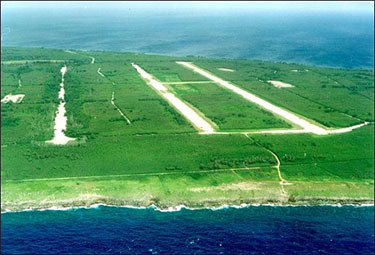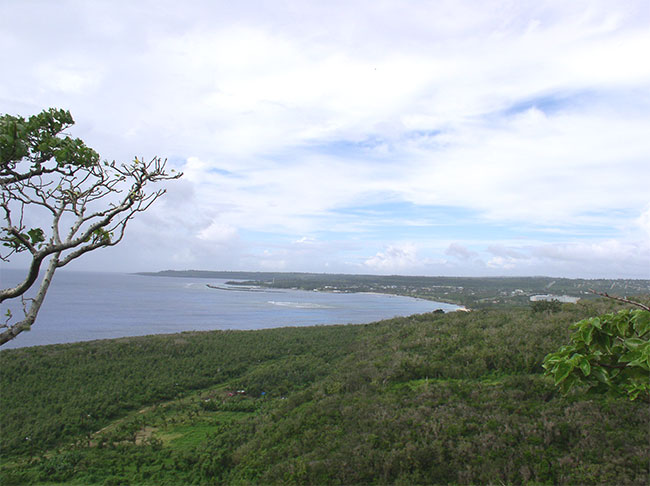 |
November 11, 2004
5 pm, San Jose Village, Tinian
It doesn’t look like it WILL be possible to transmit – from the Fleming Hotel, anyhow, because the Fleming Hotel has no telephones. Maybe I can work out something else tomorrow.
 |
| The airfield on Tinian. Photo by Herb Soll. |

San Jose Village, Tinian. Photo by Tom King.
Mr. Naftel turned out to be a spry, white-haired, distinguished gentleman, and a great story teller. We had to drag Kar away from him to pack up the cars and head for the site, where it turned out Mike Fleming had been waiting since 8:30 with a brush clearing crew.
I should say that Mike – besides being the area’s first indigenous advanced-degreed archaeologist – is a member of a very important Tinian family, which of course owns the Fleming Hotel, Store, and Restuarant, among other things So he can do things like getting a crew with a tractor and huge brush-cutting mower from the Mayor, and he had. It was good to see Mike again; he’s an old friend and a respected colleague, and he’d spent his time well tramping the site and figuring out how to handle it. Several young guys from the CNMI and Tinian Historic Preservation Offices (HPO) are on hand to help out – all with much appreciated archaeological field experience, as are Epi Cabrera and John Mark Joseph.
The site is a rather nondescript piece of land covered with tangentangen (the local equivalent of Scaevola) and tall grasses, sloping up into a limestone escarpment, just off a north-south tending road on the southwest side of the island. A brief discussion on-site was sufficient for Mike to confirm with Jennings, Bob, and Mr. Naftel how big an area needed to be cleared; he then encouraged us to leave him and his crew to it. We returned to the hotel for lunch, and he joined us an hour or so later, reporting that they’d cleared an acre or so, that we’d need to pull a lot more stuff up by the roots to allow accurate observation of contours, and that to his practiced eye, the soil doesn’t look to be more than a couple of feet deep, overlying limestone bedrock. So the plan for tomorrow is to mobilize on site early to strip the remainder of the vegetation, search for evidence of pits or mounds, and then stake out excavation units and begin to dig. If pits or mounds aren’t visible, then we’ll consider Hiro’s idea of an exploratory backhoe trench, or maybe several. Remains to be seen. Anyhow, Mike seems to have field operations very well in hand.
The project’s leaders and media people clearly wanted some time by themselves, so Kar and I tootled off to sight-see, visiting the A-bomb pits at North Field, the limestone forest on the south end of the island (where there were Buka trees!) and the poignant Japanese peace memorial on Suicide Cliff at the island’s southeast point, where a plaque bearing a prayer for the wisdom never to repeat the madness of war – placed there in 1996 – is already rusting and rickety.
Arriving back at the hotel, we found that Jim Sullivan and several others involved with The Deep had arrived, and huddles were continuing about various administrative matters from which I was happy to be excluded. There’s a full-team planning meeting scheduled for 7 this evening, and it’s now 5, so I think it’s time for a snooze.
